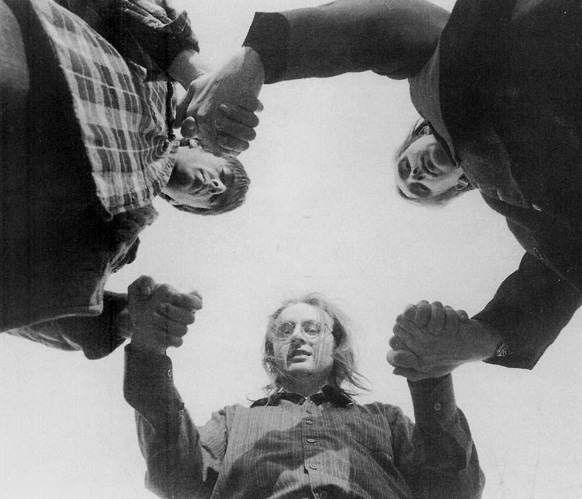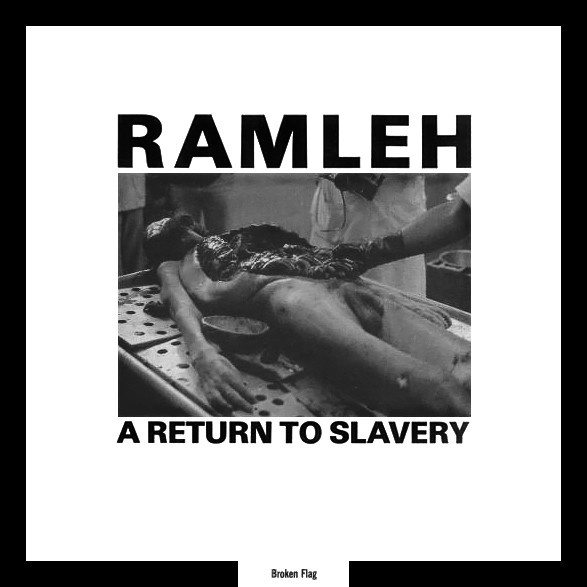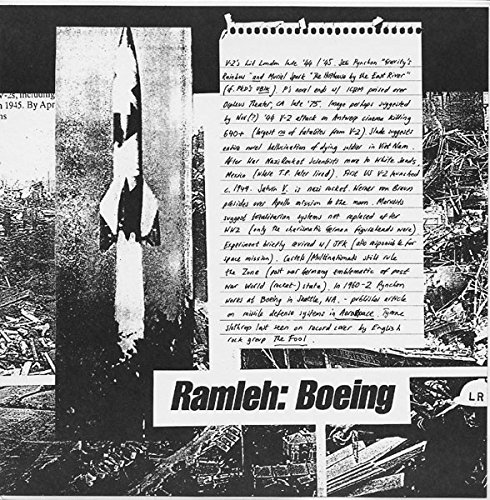Pynchon Music: Ramleh
Weird Tyranny
We were interested in fear and terror and used the things that disturbed us to influence the mood of the listener—to call up some kind of raw emotion. That kind of gut-reaction music and style worked for me then like nothing else could and made me glad to be a musician once more.
—Gary Mundy, 1992
Ramleh (1982–present)
Formed in 1982 by Gary Mundy and Bob Strudwick, Ramleh emerged from the “power electronics” scene of the early 1980s, a militantly-atonal branch of industrial music that used analogue electronics to create earsplitting walls of feedback and distortion. (Whitehouse is the most famous group associated with power electronics, and also the ones who coined the term.) Like many musicians from this scene, Ramleh embraced a nihilistic outlook that wallowed in atrocity, attempting to shock listeners with horrific imagery as well as unlistenable music: torture, executions, surgery, and violent accidents frequently adorned gig posters and cassette covers, along with iconography drawn from repellent ideologies such as Nazism, Stalinism, and Manson-like cult worship.
Ramleh shared this deliberately offensive aesthetic; their first cassette was titled 31/5/1962–1982, a “recording…planned and finally carried out on 31-5-82, 20 years to the day after the death by hanging of Adolf Eichmann at Ramleh prison in Israel, for his part in the deaths of over five million Jews during World War Two.” A year later they released A Return to Slavery, featuring a graphic depiction of—what one hopes to be—an autopsy on the cover, along with the standard Manson Family imagery. Ramleh dissolved in 1984, but Mundy reformed the band a few years later with Phillip Best of Consumer Electronics.
Ramleh’s second incarnation shifted the band’s sound from power electronics to a hard-edged blend of noise rock, space rock, and psychedelia. In 1992 Mundy gave an oft-quoted interview in which he disavowed the band’s previous use of Nazi imagery, calling it “childish” and acknowledging its potential for “danger.” A more musical statement against Nazism arrived in 1997 with Ramleh’s Boeing. Featuring a V-2 rocket on the cover, the album called attention to the relationship between Nazi Germany, the U.S. space program, and modern totalitarian systems. (More on this below.)
This second version of Ramleh broke up after Boeing; but over the years Mundy has re-formed the band several times, and a dozen musicians have been credited with membership in Ramleh. Currently, Ramleh consists of a core trio consisting of Gary Mundy, Anthony di Franco, and Martyn Watts, who released the sprawling, double-album Circular Time in 2015. This was followed by The Great Unlearning in 2019, which expanded the trio to include former bandmates Philip Best and Stuart Dennison.
Pynchon Connection
Gary Mundy is a fan of Gravity’s Rainbow, and Pynchon’s early writing informs the work of Ramleh from the beginning of their career to the present day. This is most prominently displayed on three albums:
Ramleh’s Pynchon connection begins with the song “Nordhausen” on Return to Slavery. (Originally released as a split-LP, Side 2 was titled Slaughter at Random, and was a 23-minute long piece by Libertarian Recordings, Philip Best’s group.) A critical location in Pynchon’s novel, Nordhausen is the site of Mittelwerk, the Nazi’s central V-2 factory, which used slave labor from the nearby Mittelbau-Dora concentration camp. While it’s possible Mundy may have read about Nordhausen elsewhere, the fact Boeing juxtaposes references to Gravity’s Rainbow next to images of V-2 rockets suggests a possible connection from the beginning. Recorded during Ramleh’s power electronics phase, “Nordhausen” is five minutes of brittle, glassy droning; a locust hum that almost, but not quite, sets your teeth on edge. A man is heard shouting in the background, but distortion renders his words unintelligible, and even the language is obscured—it could be Hitler exhorting the masses?
Return to Slavery concludes with “Phenol.” Also known as carbolic acid, phenol was widely used as an antiseptic during mid-century surgical procedures. Under the horrifying accords of Aktion T4, the Nazis used injections of phenol to execute people, particularly children. While phenol is not one of the numerous chemicals specifically mentioned in Gravity’s Rainbow, it’s a simple aromatic compound composed of a hydroxyl group attached to a benzene ring. And it’s derived from coal tar. As benzene rings and coal tar derivatives feature prominently in Pynchon’s novel, along with atrocities linked to the German pharmaceutical industry, it seems reasonable to connect the piece to “Nordhausen.” Eight minutes of steady, electronic hissing—the “dreaming Serpent which surrounds the World?”—“Phenol” also features a man shouting, but like “Nordhausen,” the distorted echo renders his words impossible to decipher.
Fourteen years later, Mundy brough Gravity’s Rainbow to the forefront on Ramleh’s 1997 LP, Boeing. The cover features an image of a V-2 rocket adjacent a block of hand-written text. Presumably written by Mundy, the text calls the reader’s attention to the relationship between Nazi Germany and modern “totalitarian systems,” a reference to Philip K. Dick providing a definite “The Empire Never Ended” vibe. Thomas Pynchon and Gravity’s Rainbow are mentioned by name; though a few facts are jumbled, particularly the conflation of New Mexico with Mexico proper. Nevertheless, Mundy mentions “Togetherness,” Pynchon’s article for Boeing’s Aerospace, hence the name of the album. The first track is also entitled “Knight of Wands.” While this particular card doesn’t appear in Gravity’s Rainbow, the Tarot plays an important role in the novel, and Mundy takes pains to mention “The Fool” in his liner notes. The album itself represents Ramleh in space-rock mode. An hour of galactic fuzz, plodding bass, spacey electronics, and psychedelic guitar, it’s significantly more accessible than Ramleh’s early works, and fits comfortably in the record bin somewhere between Hawkwind and Acid Mothers Temple.
The most recent incarnation of Ramleh has gone the way of the Swans, embracing sprawling double albums and adhering to more cohesive musical structures than their previous work. Circular Time contains no direct references to Pynchon, but features two songs that are likely inspired by his writing: “Ascent,” an important theme in Gravity’s Rainbow, often capitalized and appearing as the penultimate section-heading in the novel, and “Entropy,” the title of an early Pynchon story and a running theme in his work. Indeed, Ramleh member Anthony di Franco founded a record label named “Entropy.” Both songs are excellent examples of Ramleh’s current style. A musical cousin to Radiohead’s “Myxomatosis,” “Ascent” is born aloft by a muscular rhythm section and waves of propulsive guitar, while “Entropy” is ten minutes of droning distortion that sounds like an update of Boeing.
In 2019 iDEAL Recordings released The Black Book, a compilation of various artists. It contained the Ramleh track “Entropy II.” Slightly shorter than “Entropy,” the sequel offers much the same drone, but one pitched slightly higher in frequency and saturated by more static distortion.
Liner Notes
Music
Ramleh
Broken Flag, 1983
2. Nordhausen (4:39)
3. New Force (3:48)
4. Phenol (7:38)
Gary Mundy—guitar.
Bob Strudwick—electronics.
Ramleh
Majora, 1997
2. A Rag for Richey (10:56)
3. Time for a Little Something (22:52)
Gary Mundy—guitar.
Anthony di Franco—bass.
Philip Best—Moog synthesizer.
Stuart Dennison—drums.
2. Incubator (5:57)
3. American Womanhood (9:05)
4. Liberty Bell (6:28)
5. The Tower (7:04)
6. St John of the Cross (8:11)
7. The Ascent (5:53)
8. Entropy (10:11)
9. Renaissance Warfare (12:18)
10. Flamen Dialis (15:18)
11. The March (7:30)
12. Weird Tyranny (10:39)
13. Never Returner (9:36)
Gary Mundy—guitars, organ, sampler, vocals.
Anthony di Franco—bass, synth, guitar, vocals.
Martyn Watts—drums.
Additional Information
Pynchon on Record
Return to the main music page
Last Modified: 14 December 2021
Main Pynchon Page: Spermatikos Logos
Contact: quail(at)shipwrecklibrary(dot)com





